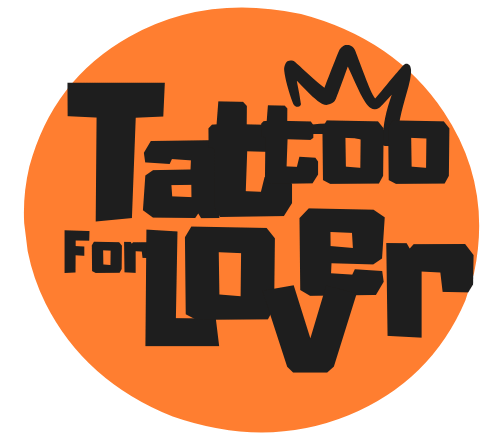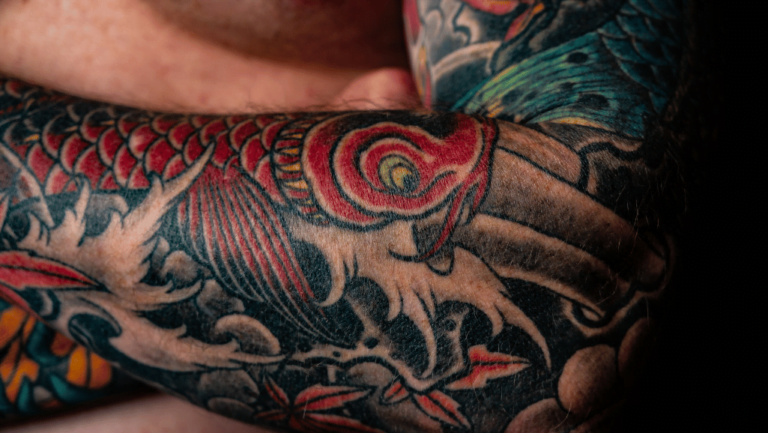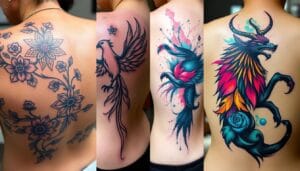Determining the cost of a color tattoo can be influenced by various factors. These include the artist’s experience, the location of the tattoo parlor, the complexity of the design, the size and placement of the tattoo, the time involved in creating the tattoo, and the style and originality of the design. In the USA, average tattoo costs in 2024 can range from $50 to $5,000, depending on the size and complexity of the tattoo. The hourly rates for tattoo artists in the USA in 2024 can vary from $80 to $250, depending on their level of experience. It’s essential to choose a tattoo artist wisely and consider all these factors when budgeting for a Color Tattoo Pricing Guide.
Key Takeaways:
- Color tattoo prices can vary depending on factors like the artist’s experience, location, and the complexity of the design.
- In the USA, average tattoo costs in 2024 range from $50 to $5,000, with hourly rates for tattoo artists ranging from $80 to $250.
- Choosing a reputable tattoo artist and considering all the factors involved can help budget for a color tattoo.
- Researching and selecting the right artist based on style and preferences is crucial for a satisfactory outcome.
- Proper aftercare is essential for the longevity and vibrant appearance of a color tattoo.
Factors That Influence Tattoo Pricing
When it comes to the cost of a color tattoo, several factors come into play. From the size and detail of the design to the complexity and sustainability of the tattoo, each element contributes to the overall pricing. Let’s explore these factors in more detail:
Tattoo Design:
The size and detail of the design can greatly impact the cost. Intricate designs with fine details may require more time and expertise to execute, resulting in higher pricing. Additionally, designs that can stand the test of time and maintain their clarity over the years tend to be priced at a premium.
Tattoo Complexity:
Complex tattoos, such as those with intricate linework or shading, often demand more effort and skill from the tattoo artist. The amount of work involved in achieving the desired level of detail can influence the pricing, as it requires additional time and precision.
Placement on the Body:
The placement of the tattoo can also affect its pricing. Some areas of the body are more challenging to work on due to their sensitivity or contours, requiring extra care and expertise. Tattoos in these areas may come with a higher baseline price.
Number of Sessions:
In some cases, achieving the desired design may require multiple sessions. Artists may price their services based on the number of sessions required, factoring in the additional time and effort involved.
Style of the Tattoo:
Different tattoo styles, such as realistic, traditional, or watercolor, may require varying levels of expertise and skill. Artists specializing in specific styles may set their rates accordingly, considering the demand and intricacy associated with each style.
Tattoo Parlor Location:
The location of the tattoo parlor can influence pricing as well. Tattoo artists in metropolitan areas, where the cost of living tends to be higher, may charge more for their services compared to artists in smaller towns or rural areas.
Keep in mind that these factors are interconnected, and a combination of them will determine the overall cost of your color tattoo. It’s important to have a detailed discussion with your tattoo artist to understand how these factors apply to your specific design and requirements.
Choosing the Right Tattoo Artist
When it comes to getting a color tattoo, selecting the right tattoo artist is crucial. The experience and reputation of the artist can greatly impact the overall cost and quality of your tattoo. Renowned and in-demand tattoo artists often charge higher rates for their time and talent, but it’s important not to focus solely on the price. Rather, it’s essential to find a tattoo artist who aligns with your style and preferences while considering their pricing structure.
Researching and reading reviews can provide valuable insights into the artist’s skill level and customer satisfaction. Additionally, browsing through portfolios can give you a sense of their artistic style and the quality of their work. This allows you to evaluate if their expertise matches your desired tattoo design.
Scheduling consultations with potential tattoo artists is highly recommended. This allows you to discuss your tattoo ideas, ask any questions you may have, and get a feel for their professionalism and personality. During the consultation, you can also inquire about their pricing structure and any additional costs that may be associated with your specific tattoo design.
Remember, the tattoo artist you choose will play a significant role in the final outcome of your tattoo. Take the time to find the best tattoo artist for your needs, balancing their experience, reputation, and pricing. By doing so, you’ll ensure that your color tattoo is not only a work of art but also a reflection of your personal style and individuality.
Understanding Tattoo Pricing Models
When it comes to tattoo pricing, there are different models that tattoo artists follow to determine the cost. By understanding these pricing models, you can better plan and budget for your color tattoo. Let’s take a closer look at the common methods used to calculate tattoo prices.
Minimum Charges
One pricing model that tattoo artists often employ is minimum charges. This is the minimum amount that a tattoo artist will charge for their services, regardless of the size or complexity of the tattoo. Minimum charges ensure that the artist’s time, skill, and equipment costs are adequately compensated.
Hourly Rates
Hourly rates are another common pricing model in the tattoo industry, especially for more detailed and time-consuming tattoos. **The cost of the tattoo per hour can vary** depending on the tattoo artist’s experience and skill level. More experienced artists usually command higher hourly rates, while apprentice or less experienced artists may charge lower rates. It’s important to discuss the expected number of hours with your chosen artist to get an estimate of the final cost.
Flat Day Rates
For larger and more complex tattoos that require extended hours of work, tattoo artists may offer flat day rates. This pricing model is suitable for customers who want to complete their tattoo in a single session or for a piece that requires multiple hours of work. Flat day rates are often more cost-effective compared to paying an hourly rate for an extended session. However, it’s essential to discuss the specifics with your tattoo artist to determine if this option is suitable for your tattoo design and budget.
Understanding these tattoo pricing models can help you make informed decisions and budget effectively for your color tattoo. Keep in mind that **the cost of a tattoo per hour, professional tattoo price list, and tattoo cost breakdown** may vary between artists and studios. It’s advisable to research multiple artists, consider their experience and portfolio, and schedule consultations to understand their pricing structure and the services provided.
| Pricing Model | Advantages | Considerations |
|---|---|---|
| Minimum Charges | Ensures fair compensation for the artist | May not account for larger or more time-consuming pieces |
| Hourly Rates | Transparent pricing based on time and skill | Cost can vary depending on the artist’s experience |
| Flat Day Rates | Cost-effective for long sessions or intricate designs | May not be suitable for small or simpler tattoos |
Remember, while **the cost of a tattoo per hour, professional tattoo price list, and tattoo cost breakdown** are important factors, the quality and skill of the tattoo artist should also be a top priority. Investing in a skilled and reputable tattoo artist ensures that you receive a high-quality and long-lasting tattoo.
The Impact of Tattoo Design and Originality
The style and complexity of the tattoo design can significantly influence the cost. Different tattoo techniques, such as single needle detail or blackout pieces, require specific skills and time, which can affect pricing. Opting for a custom design or an adaptation of existing artwork can also impact the cost, as it may involve additional time for design conceptualization. Unique and original designs often command a premium for their personalized touch.
When it comes to tattoo pricing, the design itself is a crucial consideration. Intricate, detailed designs that require precision and skill will generally incur higher costs. These designs may involve intricate linework, shading, or color blending, which demand more time and expertise from the artist.
Furthermore, if you’re looking for a one-of-a-kind tattoo that reflects your individuality, opting for a custom design or collaborating with the tattoo artist to create an original piece can be a worthwhile investment. Original designs often require additional time and effort to conceptualize and bring to life, resulting in a higher cost. However, the unique and personal nature of the design can make it well worth the investment.
Size and Placement Considerations
The size of the tattoo and its placement on the body play a significant role in determining the cost. When it comes to pricing, larger tattoos tend to require more time and detail compared to smaller, more discreet designs. The scale of the tattoo directly influences the billing, as the artist’s time and effort increase with the size of the artwork.
Moreover, specific body placements can also affect the pricing of a tattoo. Some areas, such as the rib cage or inner bicep, may be more complex to work on and require extra care and expertise from the tattoo artist. These intricate placements often come with a higher baseline cost due to the added challenges involved in executing the design with precision.
Additionally, certain body parts known for their sensitivity, like the neck or hands, may impact the overall cost of the tattoo. The complexity and potential discomfort associated with these areas can contribute to a higher price point, as the artist needs to navigate the unique characteristics of these placements.
Considering the size and placement of your tattoo is crucial in determining both the artistic possibilities and the associated pricing. Collaborating with your chosen tattoo artist will help you explore suitable sizes and placements within your desired budget, ensuring that your tattoo represents both your vision and your financial considerations.
Factors to consider when choosing the size and placement of your tattoo:
- The desired level of detail
- The impact of tattoo visibility
- The potential for design expansion or cover-ups
- Potential future considerations, such as professional limitations or personal preferences for concealment
| Tattoo Size | Example Cost Range |
|---|---|
| Small (up to 2 square inches) | $50-$200 |
| Medium (2-5 square inches) | $150-$500 |
| Large (5-10 square inches) | $500-$1,500 |
| Extra Large (10+ square inches) | $1,500+ |
The Importance of Tattoo Aftercare
Aftercare plays a crucial role in maintaining the longevity and vibrancy of your color tattoo. Failing to provide proper aftercare can lead to complications and potential risks, including infection, fading, and the loss of intricate detail. It is essential to invest in high-quality aftercare products to protect your investment and ensure the best possible outcome for your color tattoo.
Following the tattoo artist’s instructions is paramount in the aftercare process. They will provide you with specific guidelines on how to care for your tattoo in the initial healing stages. These instructions typically include keeping the tattoo clean and moisturized, avoiding excessive exposure to sunlight and water, and refraining from picking or scratching at the tattoo. By following these instructions diligently, you can promote proper healing and minimize any potential issues.
One crucial aspect of aftercare is keeping the tattoo clean. Gently washing the tattoo with a mild, fragrance-free soap will help remove any excess ink, blood, or plasma that may accumulate during the healing process. It is important to avoid using harsh products or scrubbing the tattoo vigorously, as this can irritate the skin and hinder the healing process.
Moisturizing the tattoo is another critical step in aftercare. Applying a thin layer of fragrance-free tattoo-specific moisturizer can help keep the skin hydrated and prevent it from becoming dry or cracked. This promotes the healing of the tattoo and helps preserve its vibrant colors and intricate details.
During the healing process, it is vital to protect your tattoo from excessive sunlight and water exposure. UV rays can fade the colors of your tattoo, so it is crucial to cover it when exposed to the sun or apply sunscreen with a high SPF. Additionally, submerging your tattoo in pools, hot tubs, or the ocean can increase the risk of infection. It is best to avoid swimming until the tattoo is fully healed.
Patience is key when it comes to aftercare. The healing process takes time, typically around two to four weeks, with the possibility of some tattoos taking longer. It is essential to avoid picking, scratching, or peeling the tattoo during this period, as it can disrupt the healing process and potentially lead to scarring.
Investing in proper aftercare will not only protect your color tattoo but also ensure its long-term beauty. Using a tattoo estimate calculator can give you an idea of the cost of your tattoo, including the necessary aftercare products. Remember, the investment in aftercare is just as important as the investment in the tattoo itself, so prioritize taking care of your color tattoo to enjoy it for years to come.
Conclusion
Getting a color tattoo involves careful consideration of various factors that influence the cost. These include the artist’s experience and reputation, the size and complexity of the design, the location of the tattoo parlor, and the time and effort required. To ensure the best results and longevity of your tattoo, it’s crucial to do thorough research and choose a reputable tattoo artist who aligns with your style and preferences.
Additionally, proper aftercare is essential to protect the investment made in your color tattoo. Following the artist’s instructions, keeping the tattoo clean and moisturized, and avoiding excessive sunlight and water exposure are crucial steps in maintaining the vibrancy and detail of your tattoo.
By understanding the factors that contribute to tattoo pricing and budgeting accordingly, you can make an informed decision and enjoy your color tattoo for years to come. Remember, investing in a skilled artist and diligent aftercare will ensure the best results and a tattoo you can be proud of.
FAQ
What factors influence the pricing of a color tattoo?
How does the experience of a tattoo artist impact the cost?
What are the different pricing models for tattoos?
How does the design and originality of a tattoo affect its cost?
What role does the size and placement of a tattoo play in pricing?
How important is aftercare for a color tattoo?
How can I budget for a color tattoo?
Forhad
Forhad's writing is not just about the artistry of tattoos or the latest trends in the industry; it's an exploration of the deep-rooted connections people have with their tattoos, reflecting personal narratives, cultural histories, and moments of transformation. Through a mix of in-depth features, personal narratives, and insightful analyses, he sheds light on the multifaceted nature of tattooing, revealing the emotional and cultural layers that lie beneath the surface.












